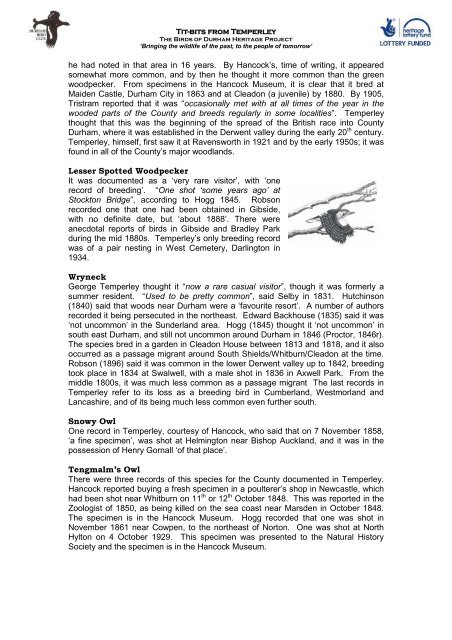'Tit-bits from Temperley' - Durham Bird Club
'Tit-bits from Temperley' - Durham Bird Club
'Tit-bits from Temperley' - Durham Bird Club
Create successful ePaper yourself
Turn your PDF publications into a flip-book with our unique Google optimized e-Paper software.
Tit-<strong>bits</strong> <strong>from</strong> Temperley<br />
The <strong>Bird</strong>s of <strong>Durham</strong> Heritage Project<br />
‘Bringing the wildlife of the past, to the people of tomorrow’<br />
he had noted in that area in 16 years. By Hancock‟s, time of writing, it appeared<br />
somewhat more common, and by then he thought it more common than the green<br />
woodpecker. From specimens in the Hancock Museum, it is clear that it bred at<br />
Maiden Castle, <strong>Durham</strong> City in 1863 and at Cleadon (a juvenile) by 1880. By 1905,<br />
Tristram reported that it was “occasionally met with at all times of the year in the<br />
wooded parts of the County and breeds regularly in some localities”. Temperley<br />
thought that this was the beginning of the spread of the British race into County<br />
<strong>Durham</strong>, where it was established in the Derwent valley during the early 20 th century.<br />
Temperley, himself, first saw it at Ravensworth in 1921 and by the early 1950s; it was<br />
found in all of the County‟s major woodlands.<br />
Lesser Spotted Woodpecker<br />
It was documented as a „very rare visitor‟, with „one<br />
record of breeding‟. “One shot ‘some years ago’ at<br />
Stockton Bridge”, according to Hogg 1845. Robson<br />
recorded one that one had been obtained in Gibside,<br />
with no definite date, but „about 1888‟. There were<br />
anecdotal reports of birds in Gibside and Bradley Park<br />
during the mid 1880s. Temperley‟s only breeding record<br />
was of a pair nesting in West Cemetery, Darlington in<br />
1934.<br />
Wryneck<br />
George Temperley thought it “now a rare casual visitor”, though it was formerly a<br />
summer resident. “Used to be pretty common”, said Selby in 1831. Hutchinson<br />
(1840) said that woods near <strong>Durham</strong> were a „favourite resort‟. A number of authors<br />
recorded it being persecuted in the northeast. Edward Backhouse (1835) said it was<br />
„not uncommon‟ in the Sunderland area. Hogg (1845) thought it „not uncommon‟ in<br />
south east <strong>Durham</strong>, and still not uncommon around <strong>Durham</strong> in 1846 (Proctor, 1846r).<br />
The species bred in a garden in Cleadon House between 1813 and 1818, and it also<br />
occurred as a passage migrant around South Shields/Whitburn/Cleadon at the time.<br />
Robson (1896) said it was common in the lower Derwent valley up to 1842, breeding<br />
took place in 1834 at Swalwell, with a male shot in 1836 in Axwell Park. From the<br />
middle 1800s, it was much less common as a passage migrant The last records in<br />
Temperley refer to its loss as a breeding bird in Cumberland, Westmorland and<br />
Lancashire, and of its being much less common even further south.<br />
Snowy Owl<br />
One record in Temperley, courtesy of Hancock, who said that on 7 November 1858,<br />
„a fine specimen‟, was shot at Helmington near Bishop Auckland, and it was in the<br />
possession of Henry Gornall „of that place‟.<br />
Tengmalm’s Owl<br />
There were three records of this species for the County documented in Temperley.<br />
Hancock reported buying a fresh specimen in a poulterer‟s shop in Newcastle, which<br />
had been shot near Whitburn on 11 th or 12 th October 1848. This was reported in the<br />
Zoologist of 1850, as being killed on the sea coast near Marsden in October 1848.<br />
The specimen is in the Hancock Museum. Hogg recorded that one was shot in<br />
November 1861 near Cowpen, to the northeast of Norton. One was shot at North<br />
Hylton on 4 October 1929. This specimen was presented to the Natural History<br />
Society and the specimen is in the Hancock Museum.


